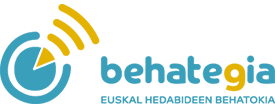On 18 January 1995, for the first time, the Global Media Monitoring Project coordinated by the World Association for Christian Communication (WACC) measured, together with the MediaWatch Canada, the representation of women in the media. Since then, global monitoring is carried out every five years. Spanish state organizations participated for the first time in the 2000 measurement, a first edition in which researchers from 71 different countries participated, currently more than 100 participating countries. From Euskal Herria in 2015 we tried to enter the measurement network, but we did not arrive in time. In 2020 we have achieved this, for the first time, the incorporation of the media of CAPV and Navarra to the global monitoring that aims to measure the presence of women in the media, according to the criteria established by the organization of GMMP Spain. However, beyond these bases, we decided to analyze in the data collection a complete sample of the Basque Country – although this data will not be included in the official investigation, but was collected in order to compare them with the general investigation.
Conversely, the COVID-19 pandemic has also influenced this monitoring. Although data collection was planned for spring, the analysis was eventually conducted on 29 September 2020. In addition, COVID-19 was included in the coding as one more item.
In the Basque Country, monitoring has also been a voluntary work in which a wide call has been made in which five PDI from the Audiovisual Communication and Advertising Department of the UPV/EHU finally participated. In addition to the sample of the Basque media requested in the measurement of the Spanish state, applying the same methodology, we decided to expand the measurement to other media that could be compared with the results obtained at international and state level. Although some preliminary results of the global measurement have been released on 4 March 2021, other data remains to be seen, so the comparison cannot be complete at this first reading.
1. Theoretical corpus
1.1 Background: Research on the role of women in the media in the Basque Country
Nativity Abril Vargas is a pioneer in the Basque Country in the analysis of the media from a commercial point of view. Professor of the Department of Journalism at UPV/EHU, in addition to being a reference in the Basque feminist movement, his doctoral dissertation has long worked on the theme: “Women as subjects of journalistic attention in the Basque press: study of the messages published in the newspapers “Deia”, “Egin”, “El Correo–El Pueblo Vasco” and “La Gaceta del Norte”. In this study, in addition to quantitatively analyzing the prominence of women, it also investigated the themes and treatment given.
Under the direction of April, Emakunde published the report entitled “The participation of women in the media and advertising in the Basque Country”. In this study, besides analyzing the presence and role of women in the CAPV media, their presence in the contents was studied, as well as the preferences of the recipients, also disaggregated by gender.
In 2013, Diana Rivero Santamaría published his thesis entitled “The situation of women journalists in the main media of the Basque Country”. 62.7% of the journalists who participated in the newsroom of the sixteen media outlets analyzed were men and 37.3% were women. The distance is further extended if you look at the direction: 76.9% men and 23.1% women (Deogracias, 2013).
Arantza Gutierrez Paz and Itxaso Fernández Astobiza, members of the research group Visibility of Women in the Media, organized a conference on the role of women in the media, sports and political journalism, cinema or video games, in the years 2010, 2011 and 2012, as well as in the “Congress Visibility of Women in the Media”. In addition, they have analyzed the presence of women in the different opinion sections and in the mass media in Hego Euskal Herria1. In 2019, the article entitled “Presence and voice of women in Basque local press forums: types of articles, profile of signatories and themes” analyzed the presence of women in the opinion sections of different local journals, as well as the topics discussed. Thus, it was concluded that the presence of women in the local press was higher than that of mainstream media, which also influenced the issues addressed and approaches (the social dimension prevailed over politics).
In addition, Emakunde (2017, 2020) has published two reports directed by researchers Simon Peña Fernández and Lucia Martínez Odriozola of the Faculty of Social Sciences and Communication of the UPV/EHU on the presence of women in the CAPV media. In the first, the presence of women in the main media of the CAPV in the period 2015-2016 was analyzed. Using the GMMP monitoring method, women studied their role as authors or as sources/subjects/objects of information. The second report, on the contrary, includes the local and regional media, whose study was conducted on 19 September. Likewise, in this second report, the researchers compared the results with those of the previous and 2015 PMM.
1.2 GMMP project: GMMP Spain and Euskal South Herria
As noted in its emblematic City 2, the global GMMP or media monitoring project is the most widespread international study that measures the transformation of gender representation in the media.
The Women Empowering Communication Congress, held in Bangkok in June, established the need to monitor the media to obtain data to serve as a basis for investigating the situations in which women live. Consequently, on 18 January 1995, the first Global Media Monitoring Project (GMMP) was held in 71 localities. Thereafter, every five years, on a pre-elected day, the role of women in the media is jointly analysed. This study voluntarily involves researchers from universities in more than 100 countries, media communicators or members of public institutions. Media was introduced on the Internet in 2010 and a social network for the first time in 2015: The research spread to Twitter.
The monitoring was carried out for the first time in the Spanish State in 2000, not including in this period nor in the 2005, 2010 and 2015 data collections any media from Hego Euskal Herria —only one means of autonomous diffusion, the Catalan radio RAC1, the only one that used a language other than Spanish in the entire sample was analyzed.
2. Methodology
2.1 GMMP project methodology
The last measurement was made on 29 September 2020. It is not known what day it was planned for, but as in the previous edition (2015) it was March 5, although it was thought to be done in March 2020, COVID-19 forced to upset the whole plan and to delay sine die. Finally, due to the improvement of the situation, during September the global monitoring exercise was carried out, but in a special situation caused by the coronavirus.
In addition to five researchers from the Department of Audiovisual Communication and Advertising of the UPV/EHU, more than 30 people have participated in data collection by monitoring at the level of the Spanish State, both from other universities (Universitat Autònoma de Barcelona, Universitat Pompeu Fabra, Facultat de Comunicació i Relacions Periodists Universidad de Prensa, Mujeres.
In total, 30 media have been investigated in the Spanish state: in addition to newspapers, radio and television, digital publications and news published from the media Twitter accounts have been observed, under the direction of UAM researcher Teresa Vera Balance. This state sample included the newspaper Gara, the informative Gaur Egun of ETB 1 and the pages of Argia and Diario de Noticias in the section corresponding to digital media.
2.2 Media in Basque
In order to know the data on the presence of women in the media in Hego Euskal Herria and compare them with the overall results, we added other media to the requested sample of GMMP Spain. In the composition of the sample, only the general media of reference in the Southern Basque Country have been taken into account. Therefore, to the aforementioned (the Gara, the portals Gaur Egun, Argia and Diario de Noticias de ETB 1) are added: the main informations of ETB 2 and Hamaika Telebista; the information programs of Radio Euskadi, Euskadi Irratia, Onda Vasca and Euskalerria Irratia. In addition to these media, we have analyzed the news published in the accounts of some Twitter media (EITB, Berria, Hala Bedi, Naiz and Diario Vasco). The choice of the media has taken into account, among others, the territorial representation of each of them, the number of listeners and the language.
In this article, in addition to the results in Hego Euskal Herria, we will focus especially on the media in Euskera, with the objective of investigating whether the language of the media is conditioning the presence of women (strengthening or decreasing it), along the road shown in previous studies (Gutierrez and Fernández, 2019).
2.3 Data sheet
In the newspapers, starting with the front page, 12-14 news or information contained on the main pages had to be coded, excluding opinions, information about services such as time or information messages. Photographic or internal news items were considered for analysis.
In the case of radio and television, it was necessary to codify all news reports (policies, local, international, reports on any topic, sports information within the informative and meteorological...). Excluding headlines, progress or analysis.
Regarding news on the Internet, 12-14 contents should be analyzed from the main website to the third level. As in previous occasions, without taking into account opinions, advertising or Youtube videos on digital portals.
On Twitter, the contents published from 6:30 p.m. were to be coded, around 15-20 tweets (one in three would have to be chosen and if this did not allow the required amount, one in two). Virutes and other contents attached thereto are not collected.
In the case of newspapers, paper contents were used; in the case of radio and television, the main informations were recorded; and the monitoring of digital content was monitored by means of a photographic screen that would allow a later analysis. Each researcher had to fill a form (see at the end of the article the Internet and Twitter form). Each file contained the following information:
- Its relationship with COVID-19. The COVID-19 was responsible for this study and the researcher had to code whether or not the news was related to it.
- Analysis: the news refers to the law or policy on equality or rights? Do you talk about women? Does it emphasize equality or difference? Does it question stereotypes?
- Gender and age of the journalist.
- Gender, age, profession, role of the protagonists in the news. Are we talking about the role with the family? Do you appear as a victim or survivor? Is it in the picture?
- Although the coding offers, especially, quantitative data, the researcher had the possibility of performing a qualitative analysis of a news item, indicating whether the new one presented a stereotyped image of women or, on the contrary, an image contrary to stereotypes. In this case a content analysis (both text and image) was performed.
In total, the sample of Hego Euskal Herria was 242 news items, 95 of them in Euskera. Texts and images have been analyzed according to the following sample:

3. Results
3.1 Presence of women in the news
The main objective of monitoring is to know the presence of women in the media. Because what is not mentioned, what is not said, does not exist (who has no name has no name). Bach Arús et al. As evidenced by the authors (2000), the media presents the androcentric approach as neutral, which is often evident when selecting sources or protagonists of the information.
Despite being half the world"s population, the presence of women in the media does not appear in the same percentage, according to several studies. UNESCO organized the Women’s Equality in the Media in Toronto from 28 February to 3 March 1995: In the Access to Expression and Decision-Making symposium, Bettina Peters reported that women appeared very few in the media and, in addition, appeared in stereotyped roles. In view of this, self-regulation was called for in the public press and media so that this does not happen. at the 4th world edition of Beijing in 1995. The conference highlighted the responsibility of the media to combat stereotypes of women.
In turn, the following studies do not show significant progress, as evidenced by the evolution of the results of the MMP:
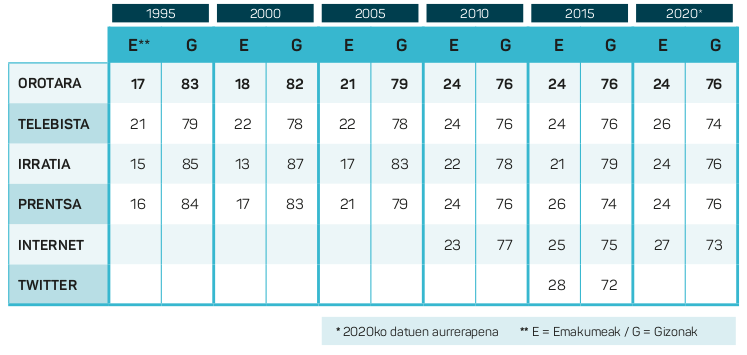
At the international level, the presence of women in the news has only increased by seven points in the last 25 years, and it is noteworthy that it has not changed in the last three monitorizations, as seen in the general numbers of data progress for 2020. That is, as has been shown in the last three studies, for every woman in the news three men appear, with no progress in the last 15 years. Later on we will also see the role of women when they appear.

On the contrary, according to the study conducted in Hego Euskal Herria, the presence of women in the media of the Basque Country and Navarre is higher than the international average, except in the press where it is equal (one woman for every three men). However, the number of men and women in the news does not correspond to the social presence. The presence of women is higher in the audiovisual media and lower in the written press. Conversely, in the Basque media, international results are exceeded by 15 points, as more than 40% of the people who appear are women. Men account for 55.3% of those exposed (4.7% of people are not identified by sex or defined as non-binary).
The research directed by Simon Peña consisted in measuring the presence of women in the news scene. The results showed that 32.1% of the news items were women and 60% men, while the remaining 7.9% were men and women (2020: 24). As explained by the authors of this study, the data are not entirely comparable, since in the case of GMMP all the people listed in the news are taken into account, and in the study conducted for Emakunde only the protagonists of the news. However, there is a tendency in the Basque media where the presence of women is higher, although information shows two men per woman, far from parity.
As far as language is concerned, there are no great differences in this study: "The presence of women and men protagonists of the news does not vary according to the language of the news. Considering that women represent 32.8%, their presence in Basque information is 32.8% and in Spanish articles it is 34.8%" (Peña et al., 2020: 44). In our study, on the contrary, there is a difference of five points and the presence of women in the media in Basque is greater; a similar trend was manifested in the analysis of the presence of women in the local press sections in Basque (Gutierrez y Fernández, 2019: 91).
3.2 Profile of women in the news
Although it is important to quantitatively quantify the presence of women, there is undoubtedly another significant data that indicates the profile of the women that appear in the news or the position they occupy.
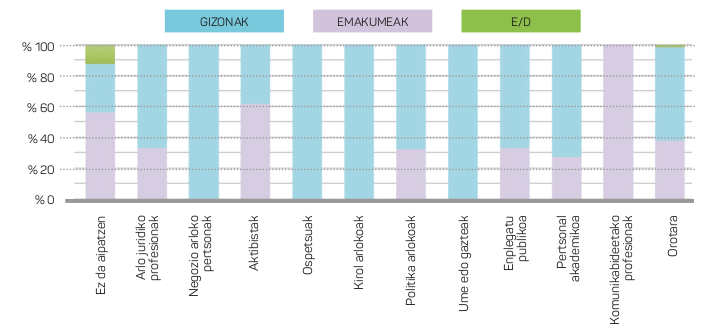
In the Basque media – press, radio and television – 119 people appear in the news analyzed, of which 45 (37.8%) are women and 72 men, while the gender of two other people has not been known. Extending the sample half, of the 325 people who appeared 110 were women (33.8%), which represents four points less female presence. The presence of political people in the news stands out (52.1%), but for every political woman that appears two men appear. Only three of the 11 university specialists present in the Basque media are women (27.3%), a much lower percentage of the media published in Spanish or bilingual (only four out of 23 specialists are women, or 17.4%). There are no women in categories like business, sports or celebrities. The two media professionals who appear are women.

Among the women who appeared in the news, the weight of policies in both the Basque media (65%) and the Basque media stands out, although in the Basque media this percentage is much lower (44%). In the analysis conducted by the research group Visibilization of Women in the Media from November 2016 to November 2017, the presence of female politicians (49.15%) in the tertulias of EITB was also significant. The local press also highlighted the presence of women politically, although with less weight (Gutiérrez and Fernández, 2019: 88).
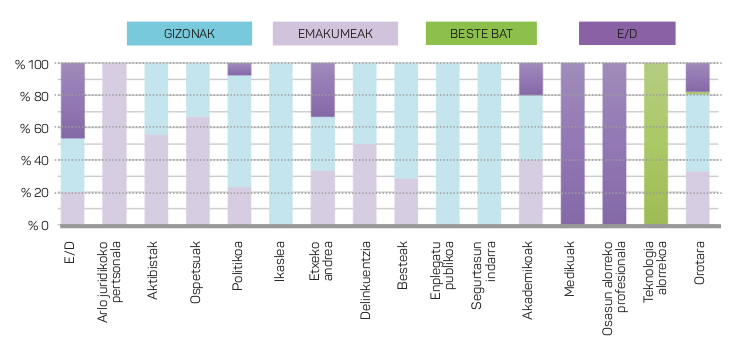
Of the 67 people listed in Internet and Twitter publications 22 are women (32%) and 32 are identified as men (47.76%). Also on the Internet are political profiles (19.40%) and activism (13.43%), although there are others such as housewives, crime or security forces. In the case of university experts, two out of five people who appear are women and men, and the other one has not been identified.
3.3 The role of women in the news
As mentioned in previous sections, women not only appear in the media, but appear very stereotyped, according to what has been evidenced in the different investigations.
Mercedes Bengoechea (2003) analyzed the presence of women in the media policy section and the conclusions showed that more than subjects of news or actions appear as objects in the information:
"The active role of women hardly appears in the journalistic discourse, and this is achieved through a series of linguistic and discursive mechanisms: the absence of women in the news and titles; the concealment or presentation of their performance using stereotypes of the active role in the discourse (entrepreneurial subject, theme, key or point of view of the phrase); or the review of sexual harassment with unnecessary powerful men; or the representation of women in the 2003, 585).
According to the opinions gathered among journalists by the report on the profession of APM (Madrid Press Association), "the image of women transmitted in the media is subject to sexual desire (50%) or victim of gender violence (47%)" (APM, 2019: 60).
In fact, women frequently appear as objects or victims in the information they use as subjects. Likewise, when the woman becomes a source of information, she appears as a witness, narrator of a personal experience or donor of citizen opinion instead of as a specialist in a subject or expert. For this reason, organizations and associations that create directories of women experts are increasing, so that the media can access them when preparing information.
As can be seen in the table below, no major steps have been taken in the last fifteen years:
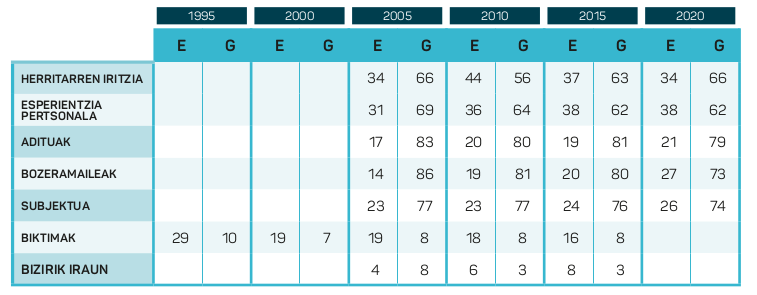
The PMM shows that the prominence of women in the news tends to be less than that of men, and that in those where an unqualified opinion and personal experience appear, while the explanation of experts or specialist opinion focuses on men (80%). In addition, international data show that the trend has not changed in recent years. Citizen opinion or personal experience is associated with the private sphere and the opinion learned to the public.
If we look at the sex of the people who appear as victims, it is clear that women are twice as many men, many of them victims of male and sexual violence, while in men the violence they suffer most is that related to armed conflict (especially war or terrorism).
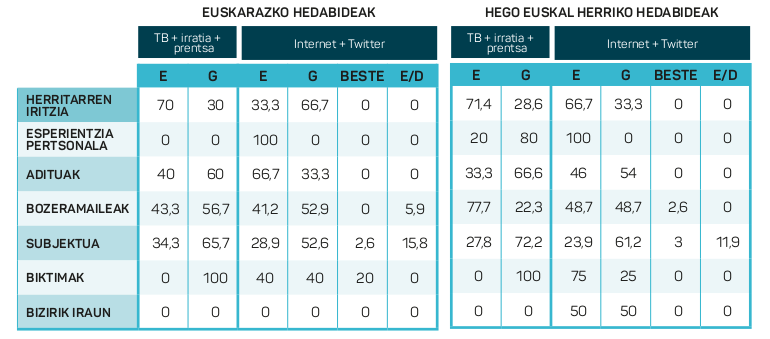
In the monitor by Hego Euskal Herria, it should be noted that women are more broadcasters of citizen opinion than of international measurements. Although the general trend, as has been pointed out, is for women to express an opinion mainly unqualified, they are also a minority in international research. In the case of personal experience, very few people have come to our role and, therefore, the results are not very expressive. It should be noted that as spokesperson for an association or organization, despite the difference, the presence of men and women is similar. Regarding the role of the subject, although the difference between men and women is smaller in the Basque media, it is evident that journalists turn to men in search of a qualified opinion, a trend that is not so pronounced in the Basque media, but that they are still far from parity.
In total, in the analyzed news five people appear as victims, one in the press (a man, victim of male violence). On the Internet and Twitter, on the contrary, four people appear as victims (three women and one man). Three of them, two women and men, have suffered sexual violence and one has been seen as a victim of armed conflict. In addition, a woman and a man appear as subjects who have survived.
3.4 Genre of news authors
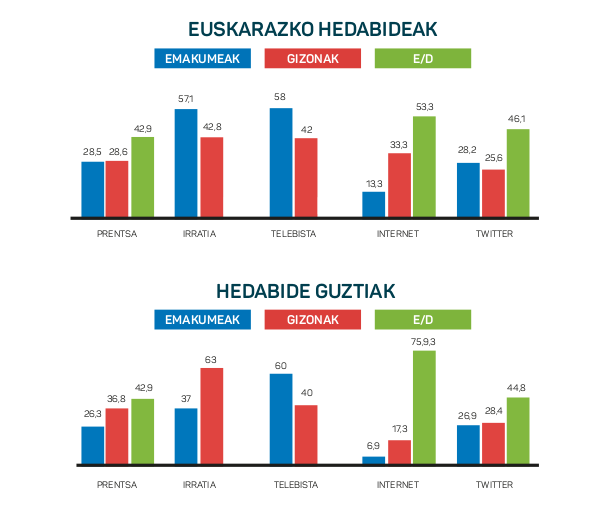

Of the 190 signatory journalists, 39 per cent are women and 45 per cent men, 15.2 per cent of the remaining signatories could not be identified. In the Basque media, the difference between women and men is much smaller, at one point, as 42.7% of signatories are women and 43.7% men. It should be noted that male voices predominate in all the channels, except in the Basque Country, where 80% of the speakers or informers are women. Likewise, much unsigned or agency information appears in both digital and print publications, so the gender or sex of the author is not identified.
According to a study by the HEKA research group in 2008, in the media published in the European minority languages, it became clear that the presence of women in the redactions was rather paritarian (Zabaleta et al., 2013), 45% and 55% media in Basque. The researchers themselves concluded that language directly influences the high representation of women, as in mainstream salaries and working conditions are worse than in minority media.
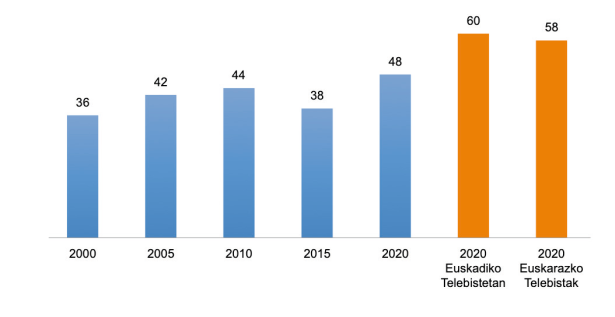
The first results of GMMP 2020 were published on 4 March 2021, including the number of women who have made television news. As can be seen from the above graph, there has been a 10 point increase in television regarding monitoring five years ago, but only four compared to 10 years ago and 12 in the last 25 years.
Regarding the television channels of Hego Euskal Herria, in the three channels analyzed, ETB 1, ETB 2 and Hamaika Telebista, the speakers of the information in study are women. Street correspondents or correspondents also predominate women. Note, however, that the only commentator who appears is a man in the informative Gaur Egun of ETB 1. Some authors consider that a greater presence of women on television may be related to image use.
3.5 The role of women in COVID-19 news
As discussed at the beginning, the COVID-19 pandemic has had a major impact on monitoring this year, not only on the organization or determination of the date of data collection, but also on the analysis, as the role of women in the informative treatment of the pandemic has been investigated.
In September 2020, the report ‘A special report on women’s under-representation in news media’, led by the International Women’s Media Foundation (Kassova, 2021), after analyzing the presence and role of women in COVID-19 information in six states, concluded that the representation of women has been very low compared to that of men. In fact, 77% of the people who appeared in the 175 stories investigated were men and only 19% were women (4% were not identified). The figure is even lower if women who still play a leading role in the news are measured, only 17% of the protagonists of the information are women and the remaining 83% are men.
The progress of the PMM results in 2020 also shows the low presence of women in COVID-19 news:
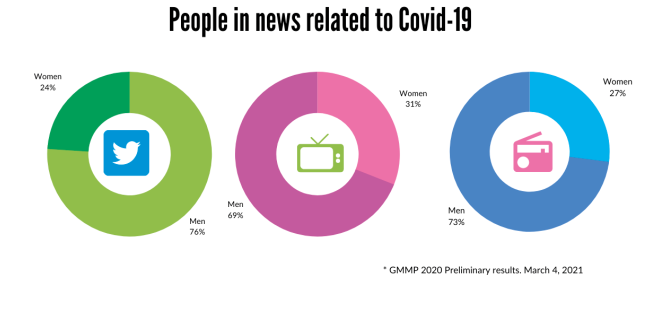
In Hego Euskal Herria we have also investigated the presence and role of women in news about COVID-19. In total, 96 news items contain content related to the pandemic, of which only 32 (33.33%) have a female presence, that is, women are one of three people in the news.
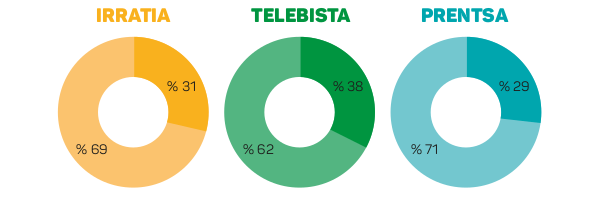
In the press, only four of the 14 COVID-19 reports (29%) show women as subjects: one expert, two politicians and another commercial. Only one woman expert in information related to the pandemic appears in the Basque media. On radio, 31% of the 29 news items (nine news items) have a woman (four as subjects, one as experts and three as spokespersons). As for the positions, eight women belong to the political sphere, one activist and the role of another is unknown. There are four politicians out of five women who appear in the Basque media. On television, 21 news items are related to COVID-19, of which only eight (38%) women play a role. As for the positions, also in this case the politicians predominate (three), and as for the roles they have in the information, three are subjects or spokespersons, while two others express their opinion as citizens.
Compared to the first results internationally, we can say that although something is higher in the media of Hego Euskal Herria, the presence of women in the news about COVID-19 is quantitatively similar and never reaches parity.
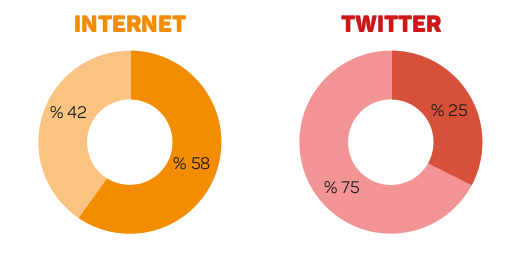
Seven of the 12 COVID-19 news found in digital publications appear women (58%), most of them political (6). In addition, a woman who can be classified as a housewife provides information about her experience. On Twitter, the presence of women is lower than in other media. In five out of 20 cases, three of them in Euskera, there is a woman -- an expert and two activists. I mean, one of the four COVID-19 news stories on Twitter shows up a woman. In this social network, the results are fully matched with international monitoring.
In both traditional media and Internet and Twitter, the presence of female experts or specialists is minimal (only three with 9.3%) and most are political (59.4%).
4. Conclusions
Having worked in Hego Euskal Herria on the analysis and results of GMMP monitoring in 2020, with special attention to the Basque media and with the objective of knowing the presence of women in our regular media, the article concludes with six conclusions:
- The presence of women in the Basque media is 10 points higher internationally, 15 points in the case of the Basque media. The press is the medium that makes women less visible in the news. Only one in four people in the newspapers in Hego Euskal Herria is a woman; one in three people is a woman in the Basque press (about 35%).
- If we look at the profession or position of women that appear in the news, it is clear that the presence of policies is above other profiles. Then there are the activists, and from there the women who work in the other areas are hardly represented. This trend, which has also appeared in previous studies, can be related to the experience of political women in the public sphere. It should be noted that as experts journalists go to men rather than women, and that the presence of women in universities or in science is 4%, although the presence of women in universities is similar to that of men (although, as is well known, there is a gender differentiation: women are the majority in the health and social sciences and men in the technological field).
- As for the roles or functions they perform in information, women usually provide unqualified opinions and personal experiences. Internationally, in this section, although the presence of women is a minority, the presence of men in the Basque media is lower. Despite the parity in the media of Hego Euskal Herria in the spokeswoman, she stresses that in the Internet publications there are more female spokesmen than men.
- In the role of subject, the international trend is also notable in the Basque media. The protagonists of the information are more men than women. As experts, it is also clear that men have more agencies. As noted above, few women appear as experts in universities or in academic and scientific fields. In 2014, thanks to the Berria scholarship, Bilgune Feminist created a digital directory of expert women named Gabiltza 4 as a tool to deal with the scarce presence of women in the media, although the project has not been widely disseminated. In the scientific field, starting in 2020, the Women in Science 5 conference is organized in order to promote the visibility of women scientists. E-makilas 6 (female engineers) or Emakumeo 7 Wiki or Visibility of women in the media are other projects to make women experts in the Basque Country visible.
- As for the gender of journalists who sign information, although the percentage of women is somewhat lower than that of men, the difference between the two is six points. On television, the Basque media are closer to parity, but they are also closer to the international level. In the press, it should be noted that many information is not yet signed or the authorship of the contents is not identified from a gender perspective, which can hide the women behind (so in recent years the movements have multiplied by the signature with names and surnames). However, although the number of women journalists is increasing, this may be an in-depth chimera. In fact, the 2019 newspaper report, produced by the APM association, reveals that women from the 100 largest media in the Spanish state occupy 25% of the leading positions. Women journalists also have more professional difficulties than men and more difficulties in promoting.
- The news of COVID-19 highlighted the low representation of women, which has joined both the monitoring carried out internationally and the study carried out in September by the IWMF Foundation. The presence of women is more marked both in the press and on Twitter. Moreover, it should be noted that the most represented women are politicians, while the presence of experts or specialists is minimal.
Bibliography
April Vargas, Nativity (1994): Women as subjects of journalistic attention in the Basque press: study of the messages published in the newspapers “Deia”, “Egin”, “El Correo–El pueblo vasco” and “La Gaceta del Norte” [doctoral thesis], UPV/EHU, Leioa.
April Vargas, Nativity (1994): Participation of women in the media and advertising of the Basque Country, Emakunde, 09, Vitoria-Gasteiz, <https://www.emakunde .euskad.eus/contents/information/elaboration_reports/es_emakunde/attachments/{\}.09.participacion.xliff-newline .comunicacion.advertising .eus.pdf>.
APM (2019): Annual Report of the Journalism Profession 2019, <https://www.ap\.es/wp-content/uploads/2020/11/{\} <https://www.apmadrid.es/wp-content/uploads/2020/11/Report-APM-2019.pdf> -APM-2019.pdf>.
Bach Arús, Marta; Altés Rufias, Elvira; Gallego Ayala, Juana, Plujà Calderón, Marta and Puig Mollet, Montserrat (2000): Berriak. Reflections on gender in information and style recommendations, Icaria, Málaga.
Bengoechea, M. (2003): “The representation of the female agency in the political sections of four Spanish newspapers”, Sociolinguistics Studies, 4(2), p. 563-587.
Deogracias, Marijo (2013): “Erredaktorea bai, zuzendaria ez”, Argia, 15-17, 2013-3-07, <https://www.argia/argia/astekaria/2373/muj-journalist>.
PMM (2021): Preliminary findings of the 2020 Global Media Monitoring Project (GMMP), <https://whomakesthenaran.org/gmmp-reports/gmmp-2020-reports/>.
Goikoetxea, Jule; Miralles, Nora; Garai, Estitxu, and Etxeberria, Lore (2017): Patriarchal democracy in the Basque Country: Paid work, unpaid work, welfare scheme and socio-political area, <https://www.euskad.eus/contents/information/ scholarships/en_def/attachments/becario.2017.2.Lists _patriarkala. pdf>
Gutierrez Paz, Arantza, and Fernández Astobiza, Itxaso (2019): The presence and voice of women in local Basque press forums: types of articles, profile and themes of the signatories, Basque Media Yearbook 2018, Observatory, <https://behina.eus/es/presentations/annuals/>.
Kassova, Luba (2021): A special report on women’s under-representation in media news, <https://www.iwmf.org/women-in-covid19-news/>.
United Nations (1996): Report of the Fourth World Conference on Women, A/CONF.177/20/Rev.1.
Peña Fernández, Simon and Martínez Odriozola, Lucía (2017): Study on the presence of women in the Basque media in 2015-2016; Emakunde, 38, <https://www.emak.euskad.eus/contents/information/es_reports/eu_emakunde/attachments/txostena/report .38.approved.
Peña Fernández, Simón; Novo Arbona, Ainhoa; Eguskiza Sesumaga, Leyre; Martínez Odriozola, Lucía, and Jiménez Martín, Eva (2020): II on the presence of women in the CAPV media. Study (2018), Emakunde; 44, <https://www.emakunde .euskad.eus/contents/information/ Reports/eu_emakunde/attachments/txostena _44_begiragas_profusa.pdf>
Peters, Bettina (1995): Discussion Document, Women and Media: Access to Media and Decision Making, UNESCO, Toronto, from February 28 to March 3, <https://www.node 50.org/womanesred/IMG/pdf/symposio95-FIP.pdf>.
Rivero, Diana (2013): The professional situation of journalists in the main media of the Basque Country (Professional situation of women journalists in the main media of the Basque Country) [doctoral thesis], UPV/EHU, Leioa.
Zabaleta, Iñaki; Xamardo, Nicolás; Gutierrez, Arantza; Urrutia, Santi and Fernández, Itxaso (2013): Presence of absence: L’embauche et le salaire comme facteurs occultant la discrimination envers les femmes journalistes dans les médias européens en es es es ens es minoritaires, E-Migrinter, 04/2013, DOI:10.4000/e-migrinter.487
Webgraphy
E-mail: https://www.eh.eus/ehusfera/e-makumeak/
Women in Science: https://emakumeakzientzia .eus/
Women"s Visual Media Competition: https://emakumeenikusentzunezkoak .word.com/
Gabiltza, digital repository of expert women https://www.gabiltza .eus/home
GMMP 2020 in English: https://whomakesthenparticipating .org/gmmp-reports/gmmp-2020-reports/
GMMP: https://whomakesthenequit.org/
International women’s media foundation: https://www.iwmf.org/
Emakumeak Wiki: https://en.wikipedia org/wiki/WikiProject:Women/Wikimujeres/Wiki
Women and media for social change: http://www.womenaction.org/women_media/eng/2/mediawatch.html
World Association for Christian Communication: https://waccamun.org/
Supplement:
Twitter tab:
Internet file:
1.- Among other issues, the report entitled ‘The presence (%) of women in the current EITB November 2016’ was presented in the Basque Parliament, which showed the low presence of women and the over-representation of men in the main EITB discussions. The work of this group is also announced by the authors Jule Goikoetxea, Nora Miralles, Estitxu Garai and Lore Etxeberria, promoted by Emakunde Beka, in the “Plan for patriarchal democracy in the Basque Country: paid work, unpaid work, welfare system and socio-political space”. Reports are available on the https group website://emakumeenikuscompet.wordspac.com/.
2.- Who Makes the News? Details of the GMMP project can be found at the https://whomakesthen 中.org/
3.- Presence of women in EITB"s current tertulias, report November 2016 - 2017 Report: https://emakumeenikusikusentzunezkoak .word.com/2017/12/19/eit-tertulegan -muj-perman
4.- https://www.gabiltz.eus/home
5.- https://women.eus/
6.- https://www.eh.eus/ehusfera/e-makume/
7.- https://eu.wikipedia .org/wiki/Wikiproject:Wiki Emakumeen
8.- https://emakumeenikusvisi.wordspac.com/
